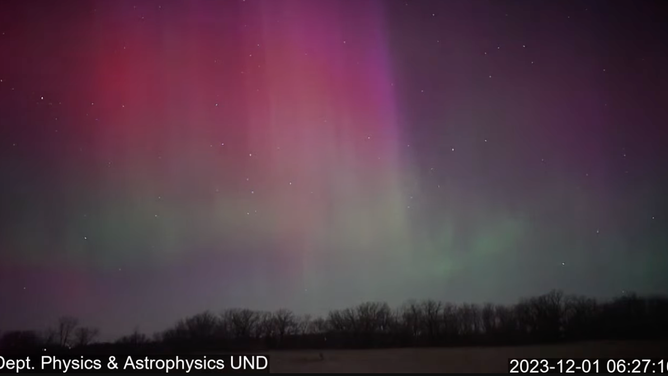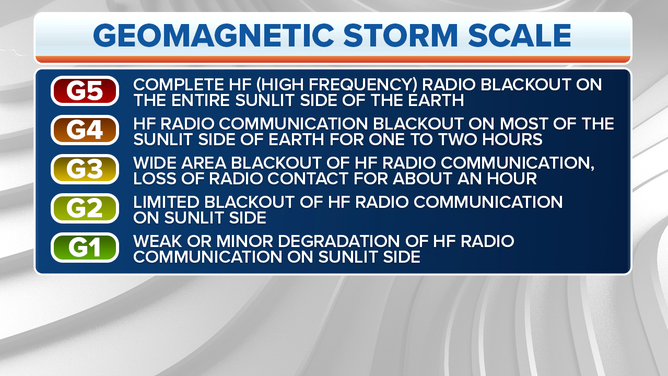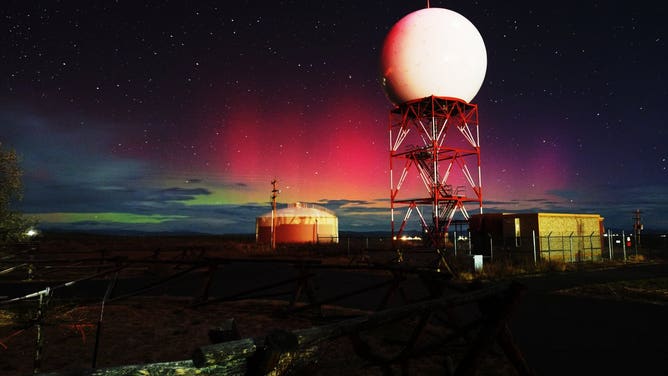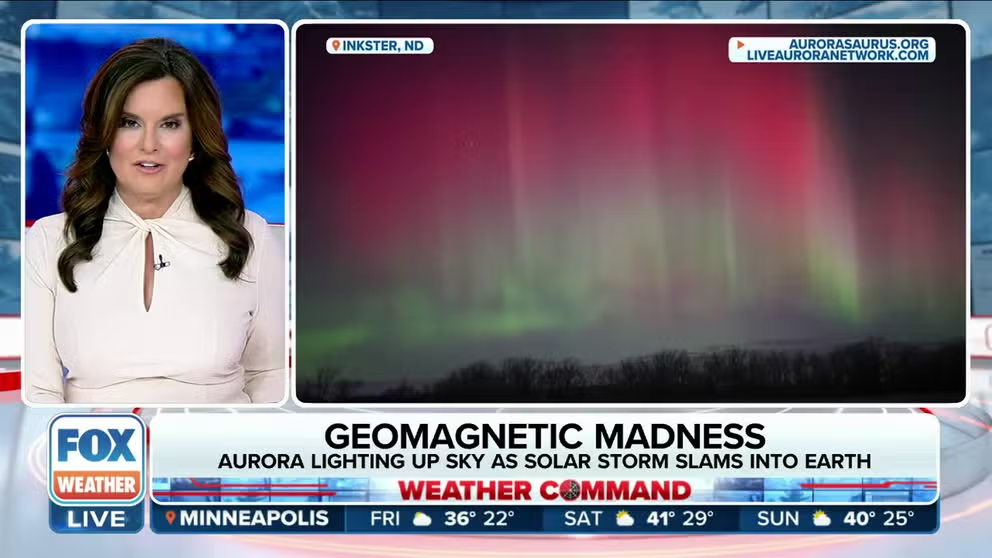Geomagnetic storm slams into Earth, triggering vivid Northern Lights display in northern US
Early Friday morning, aurora activity rapidly increased following a quiet Thursday night due to Earth's magnetic field reacting to strong incoming solar flares.
Geomagnetic storm triggers vivid display of Northern Lights across the North Friday
Skies lit up in jaw-dropping colors across North Dakota as a strong geomagnetic storm struck the Earth's atmosphere early Friday morning.
INKSTER, N.D. – A highly-anticipated geomagnetic storm roared to life early Friday morning, creating a sudden and vivid display of the Northern Lights across the northern tier of the U.S.
Early Friday morning, aurora activity rapidly increased following a quiet Thursday night due to Earth's magnetic field reacting to strong incoming solar flares.
Brilliant Northern Lights show fills skies with color over North Dakota
A strong geomagnetic storm hit Earth early Friday morning, bringing a vivid display of the Northern Lights to the northern U.S.
A live web camera at the University of North Dakota located in Inkster showed dazzling displays of green, red, and even purple pillars of aurora just after 6 a.m. local time.

Northern Lights dazzle over the skies of Grand Forks, North Dakota on Dec. 1, 2023.
(University of North Dakota / Aurorasaurus.org / LiveAuroraNetwork.com / FOX Weather)
NOAA’s Space Weather Prediction Center registered a Class 3 "strong" geomagnetic storm with the Planetary "K" index reaching a 7 out of 9 on their geomagnetic activity scale – also signifying a strong storm was underway.
WHAT ARE THE 5 CATEGORIES THAT MEASURE GEOMAGNETIC STORMS?
Unfortunately, the show was rather short-lived as the solar flare arrived just as dawn loomed for much of the nation, relegating prime dark viewing conditions to just a few hours, mostly in the West and Midwest.
Aurora triggered by multiple eruptions from the Sun
Skywatchers eagerly anticipated the light show as multiple eruptions from the Sun prompted a strong Geomagnetic Storm Watch for Friday.
The Sun is approaching Solar Maximum in its 11-year cycle, resulting in more frequent space weather events, with this week's back-to-back solar phenomena as a perfect example.
NOAA's Space Weather Prediction Center said at least three coronal mass ejections, or CMEs, happened on Sunday, sending plasma clouds from the Sun toward Earth.
7 THINGS TO KNOW ABOUT THE NORTHERN LIGHTS
On Wednesday, SWPC said a fourth CME, known as a full halo CME, prompted forecasters to upgrade the G2 watch to a G3-level geomagnetic storm watch for Friday. Full halo CMEs send out solar material away from the Sun in all directions, appearing halo-like, and usually result in geomagnetic storms at Earth.

(FOX Weather)
"The speed of this fourth CME is amplified as the others have cleared a path through the solar wind. Moving faster than the others, it will likely merge with two of the three upstream CMEs with an expected arrival at Earth overnight Nov. 30 through Dec. 1," NOAA said.
CMEs can take between 1 and 3 days to reach Earth's atmosphere. When multiple eruptions from the Sun happen, one event can overtake the other, producing back-to-back solar storms.
NOAA has a 5-point rating scale for solar storms ranging from G1 to G5, and G3 (strong) levels were observed Friday as the additional CMEs arrived.
Storms can cause intermittent satellite issues
For most, a geomagnetic storm won't have any impact. A strong (G3) storm can cause intermittent disruption to satellite navigation and low-frequency radio navigation. NOAA issues space weather forecasts to help spacecraft operators and power providers prepare their systems for potential impacts.
For the public, a solar storm can actually be exciting because the charged particles crashing into Earth's atmosphere create aurora borealis, also known as the Northern Lights. These dancing lights are most common around the poles, but with a strong solar storm, they can appear at lower latitudes.
NOAA's space weather forecasters are continuously watching the Sun using solar observation instruments on satellites to detect and forecast space weather as it happens. After a solar eruption, computer models then help determine when the particles are expected to arrive within Earth's atmosphere.
On Tuesday, NOAA Space Weather Prediction Center said a powerful M-class solar flare created a high-frequency radio blackout event. The M9.8 solar flare created a moderate HF Radio Blackout Event, and the associated flare was recorded by NOAA's GOES-19 satellite. HF radio degradation was possible over the eastern portion of the South Pacific Ocean when the flare was in progress, according to NOAA.
MESMERIZING VIDEO: 'WATERMELON' AURORA DANCES OVER ALASKA
The SWPC said because of the recent activity, it's possible for more M-class flares and a slight chance for X-class flares, the strongest on NOAA's scale.
Solar flares are classified by their strength, with five categories designated by the letters. M and X-class flares are the strongest. An X-class flare is the largest explosion and can produce as much energy as 1 billion atomic bombs, according to NASA.

The Northern Lights dancing above the Riverton, Wyoming National Weather Service office on Sunday, Nov. 5, 2023. (Image: NWS Riverton)
Recent solar storms in November created vivid displays of the Northern Lights as far south as the Carolinas.
The SWPC estimates we're just months from the peak of Solar Cycle 25, as they recently moved up their forecast of the solar maximum to now occurring sometime between January and October 2024.

